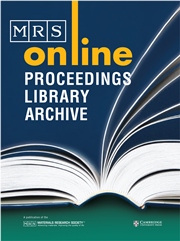Article contents
Highly Conductive and Optically Transparent Polycrystalline Iridium Oxide Thin Films Grown by Reactive Pulsed Laser Deposition
Published online by Cambridge University Press: 10 February 2011
Abstract
Reactive pulsed laser deposition has been used to deposit IrO2 thin films on both SiO2 and fused quartz substrates, by ablating a metal iridium target in oxygen atmosphere. At a KrF laser intensity of about 1.7 × 109 W/cm2, IrO2 films were deposited at substrate deposition temperatures ranging from room-temperature to 700 °C under an optimum oxygen ambient pressure of 200 mTorr. The structure, morphology, electrical resistivity and optical transmission of the deposited films were characterized as a function of their deposition temperature (Td). High quality IrO2 films are obtained in the 400–600 °C deposition temperature range. They are polycrystalline with preferred orientations, depending on the substrate, and show a dense granular morphology. At a Td as low as 400 °C, highly conductive IrO2 films with room-temperature resistivities as low as (42±6) μΩ cm are obtained. Over the 300–600 °C Td range, the IrO2 films were found to exhibit a maximum optical transmission at 450 °C (∼ 45 % at 500 nm for 80 nm-thick films).
- Type
- Research Article
- Information
- Copyright
- Copyright © Materials Research Society 1997
References
REFERENCES
- 4
- Cited by




